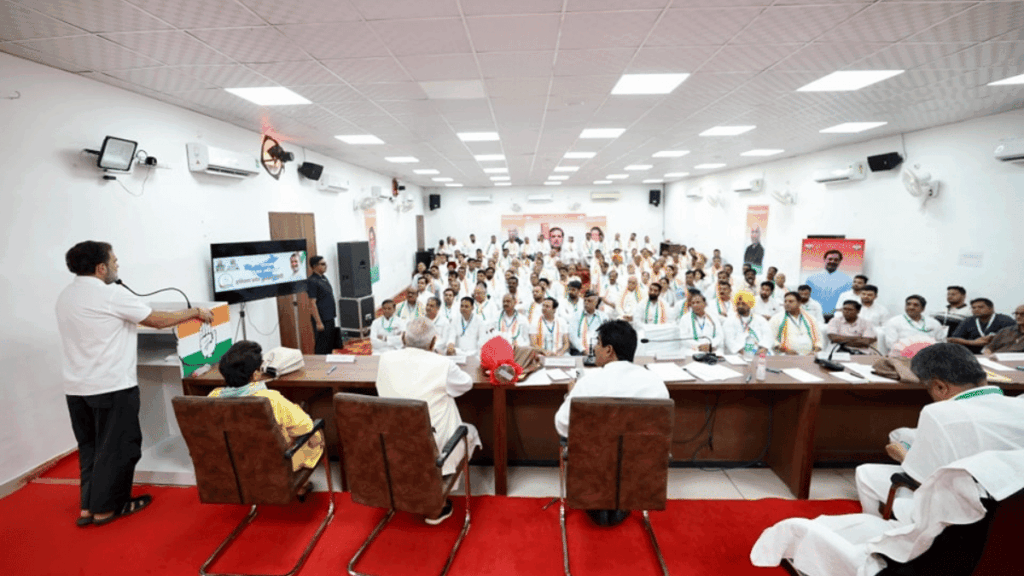Gurugram: In a shift aimed at reclaiming the ground it lost in the 2024 Haryana assembly elections within months of strong performance in the state in the Lok Sabha polls, the Congress has evidently followed the Bharatiya Janata Party’s (BJP) successful caste-based strategy while effecting a major organisational overhaul in 11 years.
By relying on non-Jat communities, particularly Other Backward Classes (OBCs), while appointing 32 district presidents recently, the Congress has signalled a deliberate shift away from its traditional Jat-centric voter base to build a more inclusive caste coalition, aiming to challenge the BJP’s dominance which has been in power in the state since 2014.
A look at the Congress’s list of district presidents announced on 12 August shows the party’s restructuring mirrors the BJP’s approach, which secured its third consecutive term in Haryana by consolidating non-Jat and OBC votes.
Ahead of the 2024 state elections, the BJP replaced its chief minister for 10 years Manohar Lal Khattar with Nayab Singh Saini, an OBC leader. It proved to be a masterstroke in appealing to backward classes, as the party won the Assembly election, defying all predictions of a Congress victory.
Also Read: In faction-ridden Haryana, Rahul’s revival mission for Congress calls for return to basics
Mimicking BJP’s caste calculus
Taking a leaf out of the BJP’s playbook, the Congress has appointed 10 OBC district presidents, including four Gujjars (Ramchandra Gujjar and Netrapal Adhana among them), three Yadavs (Vardhan Yadav, Satyavir Yadav, Sanjay Yadav) and three from other OBC castes.
This move is being seen as a direct response to the BJP’s “Saini card”, and the Congress positioning itself as an advocate of OBCs in the next electoral cycle. The BJP recently announced 27 district presidents for Haryana’s 22 districts, with additional presidents for areas like Hansi, Greater Gurugram, Gohana, Dabwali, and Ballabhgarh, hinting at potential new district formations in the state.
The BJP appointed eight OBC district presidents, five Brahmins, five Punjabis, four Jats, two Rajputs, two Scheduled Castes (SC), and one Bania, with four women included in the list. This diverse representation underscores the BJP’s strategy of balancing caste equations while maintaining a broad caste appeal.
For the Congress, it was the first instance of setting up district organisations the state in 11 years—no organisational structure could be set up when Ashok Tanwar was Haryana Pradesh Congress Committee chief from 2014 to 2019, or when Kumari Selja was at the helm from 2019 to April 2022 or in the first three years of incumbent state president Udai Bhan who took over from her.
Cutting on Jat dominance
Historically reliant on Jat votes, which account for roughly 25 per cent of Haryana’s population, the Congress has now deliberately reduced Jat dominance in its organisational structure.
Only six Jat leaders—Anirudh Choudhary (Bhiwani Rural), Rishipal Singh (Jind), Mewa Singh (Kurukshetra), Ramesh Malik (Sonipat Rural), Sanjeev Kumar Dahiya, and Parvinder Pari (Ambala Cantt)—have been appointed as district presidents.
Even in Jat strongholds like Rohtak and Jhajjar, non-Jat leaders have been made district presidents, marking a departure from the party’s Jat-centric politics which backfired in the 2024 elections due to limited consolidation.
Political analyst Kushal Pal, principal at Indira Gandhi PG College, Ladwa, told The Print Monday the Congress appears to have learnt from its electoral mistakes.
“Before the 2024 elections, it was presumed that the BJP’s appointment of Nayab Saini as CM would polarise voters on Jat versus non-Jat lines. However, the Congress itself turned the election into a Jat versus non-Jat contest with the party projecting Bhupinder Singh Hooda as the next CM in almost every election meeting,” Pal said.
“Casteist remarks against Selja by a Congress leader in Narnaund, where Hooda loyalist Jassi Petwar was contesting, and Selja’s subsequent absence from the campaign worsened the situation. The new district president list shows the Congress is now correcting these mistakes,” he said.
Broadens appeal to general, minorities
To widen its voter base, the Congress has appointed nine non-Jat general category leaders, including three Punjabis, two Banias, two Rajputs and two Brahmins, targeting urban and trading communities.
Besides, five SC leaders and one Muslim leader have been appointed to strengthen Congress’s hold in Mewat and appeal to minority communities.
Pal noted that Dalits, traditionally Congress voters, had been drifting away from the party. “With five SC district presidents, compared to the BJP’s two, the Congress is making a concerted effort to win back Dalit support,” he said.
The appointments also reflect Congress’s attempt to balance its internal factions, particularly between former chief minister Bhupinder Singh Hooda and Kumari Selja.
Hooda’s faction dominates the list, but Selja’s camp has secured key positions, especially in geographical area along the Grand Trunk Road, or the GT Belt (Panchkula, Ambala, Yamunanagar, Kurukshetra, Karnal and Panipat), which has 11 district units.
Of these, five leaders each from the Hooda and Selja camps have been accommodated.
Hooda’s faction dominates Karnal, Kurukshetra, and Panipat Rural, with Panipat Urban’s appointment still pending.
Lesson from 2024
Jyoti Mishra, assistant professor of Political Science at Amity University, Mohali, and a former researcher at the Centre for the Study of Developing Societies (CSDS), told The Print that Congress’s 2024 defeat stemmed from its over-reliance on Jat leadership and the assumption that Jat votes alone would suffice.
“The BJP, in contrast, built a broad coalition, fielding candidates and running campaigns that appealed to diverse caste groups, which paid off handsomely. The Congress is now widening its scope through this leadership restructuring,” Mishra said.
She added that by appointing OBCs, Dalits, Brahmins, Punjabis, and other non-Jat leaders, the Congress is signalling inclusivity. “This strategy not only counters the perception of being a Jat-centric party but also positions the Congress to connect with a broader societal cross-section. If sustained with consistent outreach, this approach could significantly bolster the Congress’s prospects in Haryana,” Mishra concluded.
(Edited by Ajeet Tiwari)
Also Read: Cracking whip on officials with suspensions & salary cuts, Saini govt follows in Khattar’s footsteps

